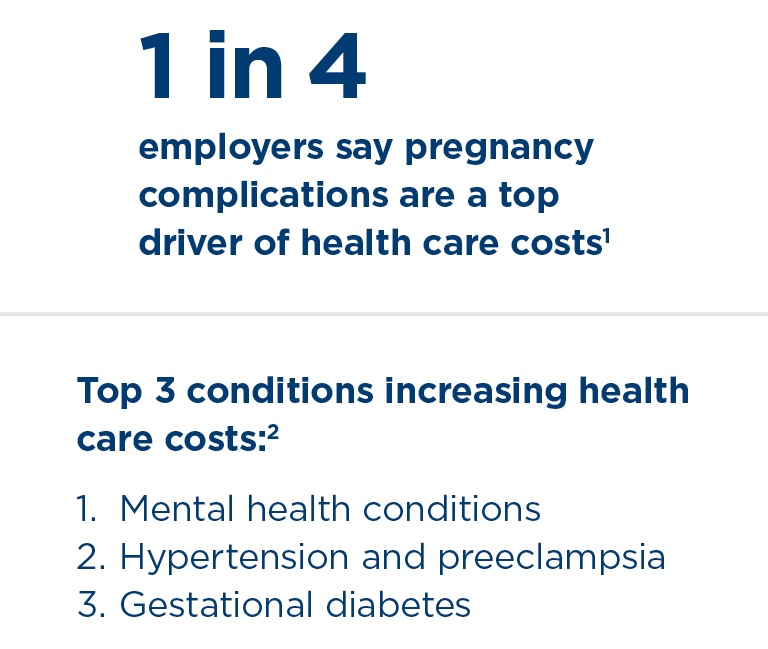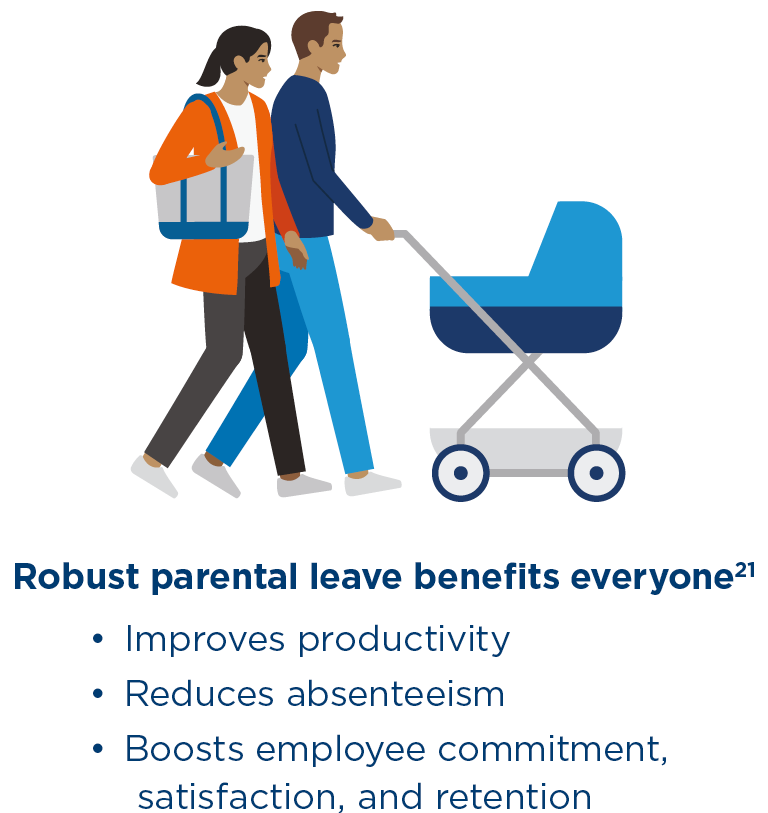

High-risk pregnancies are an increasingly common and costly concern for working parents and their employers, accounting for billions of dollars in health care spending every year. The impact of physical, mental, and social health concerns during pregnancy is on the rise — increasing the likelihood of complications with pregnancy. By proactively addressing these challenges, employers can support their pregnant employees and their growing families in meaningful ways.
Innovations in perinatal care and support are improving health outcomes, reducing costs, and helping pregnant employees remain productive and engaged at work. It’s more essential than ever for business leaders to invest in health care that’s proven to prevent — and safely manage — conditions related to high-risk pregnancies.
What is a high-risk pregnancy?

A high-risk pregnancy is any pregnancy that carries greater health risks for the pregnant person, the baby, or both. There are many reasons why a pregnancy may be considered high risk. Sometimes it’s because of a condition that a person has prior to becoming pregnant, like diabetes or high blood pressure. In other cases, complications develop during pregnancy, such as preeclampsia or gestational diabetes.
Pregnant people who are age 35 or older, or who are obese, or who are having multiple births (twins, triplets) are also at higher risk for complications.


The high cost of pregnancy complications
When complications arise before, during, or after childbirth, the cost of care can grow exponentially. Pregnancies resulting in cesarean section cost 77% more than vaginal births and require longer recovery times.3 On average, premature babies spend 25 days in the hospital at a cost of $145K.4 And first-year health care costs for low-birth-weight babies are $29K higher than their average-weight counterparts.5 Understandably, complications like these also result in indirect costs like productivity loss, absenteeism, and sick leave.6


Innovations transforming high-risk pregnancy care
Remote monitoring, virtual care, and integrated psychosocial support are empowering care teams to prevent complications, minimize costs, and improve outcomes of high-risk pregnancies. Choosing a health plan that actively embraces these innovations is critical to your workforce health strategy.

Virtual prenatal care and remote monitoring
Telehealth visits can be a game-changer for pregnant patients who need more frequent care interactions — reducing time off for in-person appointments while simultaneously providing the robust specialized physical and mental health support they need.
Wearable devices, mobile apps, and other tools allow care teams to monitor at-risk patients — and respond to evolving needs quickly. These tools offer real-time visibility into parental and fetal health, helping clinicians spot potential complications before they become serious. They’ve also been shown to help employees effectively self-manage health conditions like high blood pressure.9
“High-risk pregnancy is a great use case for remote monitoring,” explains Mara Greenberg, MD, a Kaiser Permanente maternal-fetal medicine specialist in Northern California. “It can help us stay on top of many different conditions during pregnancy, particularly those related to blood pressure and blood sugar. We can use Bluetooth-enabled home monitoring devices to get vitals and other patient data directly into their electronic medical record. These tools can help care teams catch issues that require attention and address them promptly.”
Integrated, patient-centered, holistic prenatal care
In an integrated health care system, patients’ electronic medical records connect the dots between different locations and specialists. Integrated care also enables standardized practices and protocols, so all sites of care are prepared to respond to the patient’s condition.
“At Kaiser Permanente, we have large databases and algorithms that can help identify risks in patients, and rich data from routine screenings and remote monitoring,” says Dr. Greenberg. “Our electronic medical records help us tie all that information together to see a big-picture view of their health. So, we’re able to detect problems among pregnant and postpartum patients early and collaborate to move them through the appropriate levels of care more effectively.”
Embedded mental health support
Anxiety and depression are common perinatal conditions that can drive absenteeism, lower productivity, and have serious health impacts.10 For example, pregnant people who are depressed are at higher risk for preterm birth and low birth weight, and households affected by postpartum depression can incur 22% higher medical and pharmaceutical spending during the first year following childbirth.11,12
Mental health conditions are the most common underlying cause of maternal mortality. 13
With regular mental health screenings embedded in routine prenatal care, clinicians are better able to identify and support the 22% of pregnant patients who experience mood disorders — and identify mental health needs in employees who might not seek care on their own.14
How employers can support a healthy pregnancy experience
With an estimated 70% of pregnant people in the U.S. working during their pregnancies, investing in high-quality, evidence-based pregnancy care makes good business sense.15,16

Champion preventive prenatal care
Timely prenatal care is proven to reduce complications and costs.17 Encourage pregnant employees to take advantage of preventive care by:
- Normalizing time off for regular screenings and assessments
- Choosing a health care partner who offers virtual care and remote patient monitoring
- Offering a stipend to cover doula services
- Providing educational resources about the risks and warning signs of high-risk pregnancy and the importance of prenatal care
- Promoting the benefits, services, and protections available to employees
Offer adequate leave and accommodations
Over half of people who give birth in the U.S. return to work during their child’s infancy, and some experience lingering health issues related to pregnancy and giving birth.18 Employees who take longer parental leave are healthier during their first month back at work — and those who take at least 17 weeks off are healthiest.19
In addition to leave, remote work options can provide the flexibility employees need to rest and seek care as needed. Working full-time or part-time from home can increase positive mentality in new parents by up to 42%.20


Make a plan to support growing families
Investing in high-quality perinatal care is a workforce health imperative. With risk factors trending up, providing access to proactive, evidence-based health care is the best way to support employees who want to have children — and to avoid the high costs associated with complications during pregnancy.22 In addition to boosting productivity and minimizing absenteeism, these innovative measures have also been shown to increase overall company morale, and foster loyalty and commitment, helping you retain valued employees.23
With proper prenatal care, careful monitoring, and proactive management, many people with high-risk pregnancies deliver healthy babies. If your employees are looking to expand their families, help them safely plan by providing the coverage, space, and support they need for a healthy pregnancy, delivery, and postpartum experience.
About our expert

Dr. Greenberg is a maternal-fetal medicine specialist and leader in obstetric research. She currently serves as director at a Northern California telehealth center serving patients with high-risk conditions, was a founding member of the regional Women’s Health Equity task force, and is an active member of the American College of Obstetricians and Gynecologists and the Society for Maternal-Fetal Medicine. In all roles, she works to elevate the standards for evidence-based and equitable practices in obstetrics.
She holds a medical degree from the University of Pittsburgh, did her ob-gyn residency at University of California, San Francisco, and completed a maternal-fetal medicine fellowship at Stanford.
Additional resources you may find helpful



- 1
“Addressing Top Cost Conditions: High-risk Maternity and NICU,” Business Group on Health, April 14, 2021.
businessgrouphealth.org/resources/addressing-top-cost-conditions-high-risk-maternity-and-nicu - 2
“Pregnancy and Delivery Complications Cost the United States Billions in Health Care Expenses, Lost Productivity, and Social Support Services,” The Commonwealth Fund, November 12, 2021. commonwealthfund.org/press-release/2021/new-report-pregnancy-and-delivery-complications-cost-united-states-billions
- 3
Matthew Rae, et al., “Health Costs Associated With Pregnancy, Childbirth, and Postpartum Care,” Peterson-KFF Health System Tracker, July 13, 2022.
healthsystemtracker.org/brief/health-costs-associated-with-pregnancy-childbirth-and-postpartum-care - 4
“Rethinking How Employers Address High-cost Claims,” National Alliance of Healthcare Purchaser Coalitions, accessed January 3, 2024.
www.nationalalliancehealth.org/wp-content/uploads/NationalAlliance_HCC-RPT_FINAL.pdf - 5
Nguyen Xuan Thanh, et al., “Health Service Use and Costs Associated with Low Birth Weight —A Population Level Analysis,” National Library of Medicine, September 2015.
pubmed.ncbi.nlm.nih.gov/26148659/ - 6
Lynn Falletta, et al., “Work Reentry After Childbirth: Predictors of Self-Rated Health in Month One Among a Sample of University Faculty and Staff,” National Library of Medicine, March 2020.
ncbi.nlm.nih.gov/pmc/articles/PMC7078554/ - 7
See note 4.
- 8
See note 3.
- 9
MG Ramos-Zavala, et al., “Comparison of the Use of Blood Pressure Telemonitoring Versus Standard Medical Care in the Achievement of Short-term Therapeutic Goals in Blood Pressure in Patients with Uncontrolled Hypertension: An Open-label Clinical Trial,” JRSM Cardiovascular Disease, June 12, 2023.
journals.sagepub.com/doi/full/10.1177/20480040231178585 - 10
See note 6.
- 11
“Depression During Pregnancy,” March of Dimes, accessed January 3, 2024.
marchofdimes.org/find-support/topics/pregnancy/depression-during-pregnancy - 12
C Neill Epperson, et al., “Healthcare Resource Utilization and Costs Associated With Postpartum Depression Among Commercially Insured Households,” National Library of Medicine, August 7, 2020.
https://pubmed.ncbi.nlm.nih.gov/32696705/ - 13
“Four in 5 Pregnancy-related Deaths in the U.S. are Preventable,” Centers for Disease Control and Prevention, September 19, 2022.
cdc.gov/media/releases/2022/p0919-pregnancy-related-deaths.html - 14
See note 6.
- 15
Jessica Mason and Katherine Gallagher Robbins, “Discrimination While Pregnant,” National Partnership for Women & Families, October 2022.
nationalpartnership.org/report/discrimination-while-pregnant - 16
“Understanding and Controlling Maternity Costs in Your Workplace,” Maven Clinic, February 2, 2024.
mavenclinic.com/post/understanding-and-controlling-the-high-costs-of-fertility-and-pregnancy - 17
Jesse Migneault, “Population Health Approach to Prenatal Care Cuts Payer Costs,” Health Payer Intelligence, April 26, 2017.
healthpayerintelligence.com/news/population-health-approach-to-prenatal-care-cuts-payer-costs - 18
See note 6.
- 19
See note 6.
- 20
Christine Michel Carter, “Employers Can Benefit by Taking Maternal Mental Health Seriously, Research Shows,” Forbes.com, May 2, 2023.
forbes.com/sites/christinecarter/2023/05/02/employers-can-benefit-by-taking-maternal-mental-health-seriously-research-shows - 21
“Accommodating Pregnant Workers Is Good for Business,” National Women’s Law Center, September 2020.
nwlc.org/wp-content/uploads/2020/01/New-PWFA-Factsheet.pdf - 22
See note 20.
- 23
See note 21.
Kaiser Permanente health plans around the country: Kaiser Foundation Health Plan, Inc., in Northern and Southern California and Hawaii • Kaiser Foundation Health Plan of Colorado • Kaiser Foundation Health Plan of Georgia, Inc., Nine Piedmont Center, 3495 Piedmont Road NE, Atlanta, GA 30305 • Kaiser Foundation Health Plan of the Mid-Atlantic States, Inc., in Maryland, Virginia, and Washington, D.C., 2101 E. Jefferson St., Rockville, MD 20852 • Kaiser Foundation Health Plan of the Northwest, 500 NE Multnomah St., Suite 100, Portland, OR 97232 • Kaiser Foundation Health Plan of Washington or Kaiser Foundation Health Plan of Washington Options, Inc., 1300 SW 27th St., Renton, WA 98057
Congratulations! You have successfully saved this item.
To access your Saved items any time, open the "Saved Items" folder in the top right corner of the page.
It seems that you do not have cookies enabled. Please enable cookies to make use of all of our site's functionality.
You haven't collected any items yet.
- Save Content
Click the "Save" icon next to the content you want to revisit later.
- Access Your Saved Items
Click on the "Saved Items" link at the top of the page or use the URL we create for you.
Be sure to copy and paste the URL we create for you before you leave the site.
1-5 of 14
Your Link
After leave the site, your saved items will be saved for you at this URL:
https://business.preview.dpaprod.kpwpce.kp-aws-cloud.org/saved-items?user=Share your list
Show Disclaimer +


